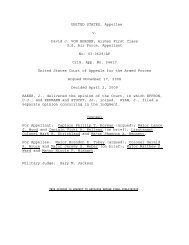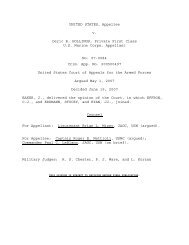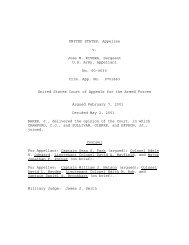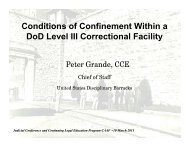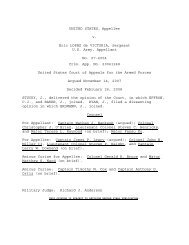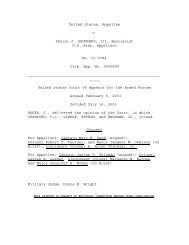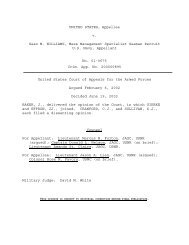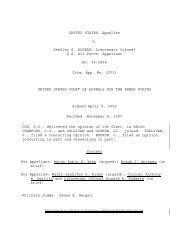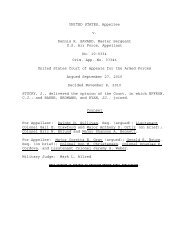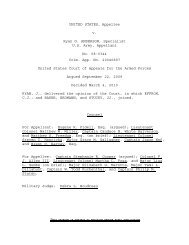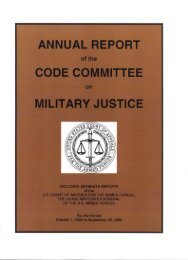United States v. Miller - U.S. Court of Appeals for the Armed Forces
United States v. Miller - U.S. Court of Appeals for the Armed Forces
United States v. Miller - U.S. Court of Appeals for the Armed Forces
You also want an ePaper? Increase the reach of your titles
YUMPU automatically turns print PDFs into web optimized ePapers that Google loves.
<strong>United</strong> <strong>States</strong> v. <strong>Miller</strong>, 08-0580/ARsame result would likely obtain on retrial.” Dunn v. <strong>United</strong><strong>States</strong>, 442 U.S. 100, 107 (1979); see also Chiarella v. <strong>United</strong><strong>States</strong>, 445 U.S. 222, 236-37 (1980) (stating that <strong>the</strong> <strong>Court</strong>would not affirm a conviction based on a <strong>the</strong>ory not presented to<strong>the</strong> jury). “To uphold a conviction on a charge that was nei<strong>the</strong>ralleged in an indictment nor presented to a jury at trial<strong>of</strong>fends <strong>the</strong> most basic notions <strong>of</strong> due process.” Dunn, 442 U.S.at 106.Article 79, UCMJ, which provides that an accused “may befound guilty <strong>of</strong> an <strong>of</strong>fense necessarily included in <strong>the</strong> <strong>of</strong>fensecharged,” is consonant with <strong>the</strong>se constitutional principles, andapplies at both <strong>the</strong> trial and appellate levels. See Article 59,UCMJ (allowing an appellate court to affirm a conviction to alesser included <strong>of</strong>fense). In <strong>the</strong> explanation <strong>of</strong> Article 79,UCMJ, <strong>the</strong> President advises that “[a] lesser <strong>of</strong>fense is includedin a charged <strong>of</strong>fense when <strong>the</strong> specification contains allegationswhich ei<strong>the</strong>r expressly or by fair implication put <strong>the</strong> accused onnotice to be prepared to defend against it in addition to <strong>the</strong><strong>of</strong>fense specifically charged.” MCM pt. IV, para. 3.b(1). 5The notice requirement is met when “<strong>the</strong> elements <strong>of</strong> <strong>the</strong>accused actively resisted <strong>the</strong> apprehension. MCM pt. IV, para.19.b(1).5 “Although MCM explanations <strong>of</strong> <strong>of</strong>fenses are not binding on this<strong>Court</strong>, <strong>the</strong>y are generally treated as persuasive authority, to beevaluated in light <strong>of</strong> this <strong>Court</strong>’s precedent.” <strong>United</strong> <strong>States</strong> v.<strong>Miller</strong>, 67 M.J. 87, 89 (C.A.A.F. 2008) (citations omitted).7



